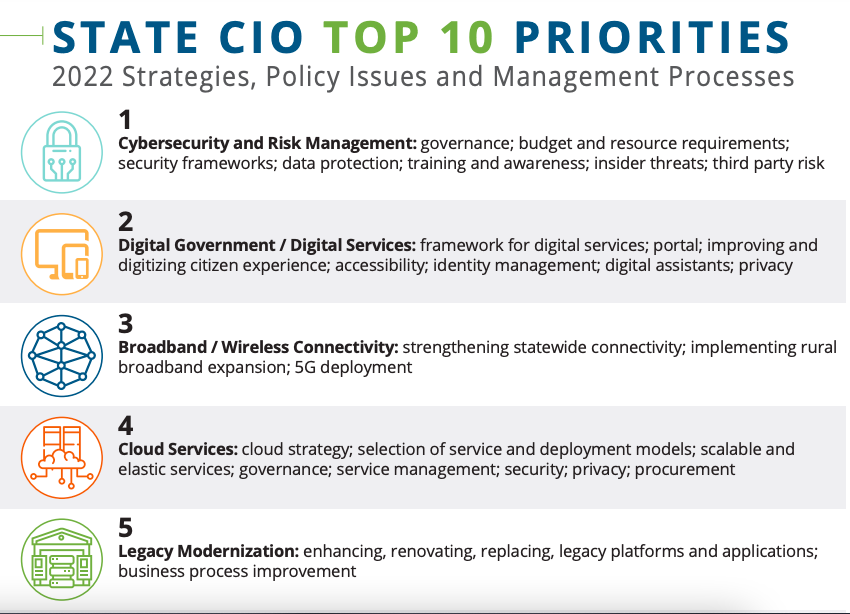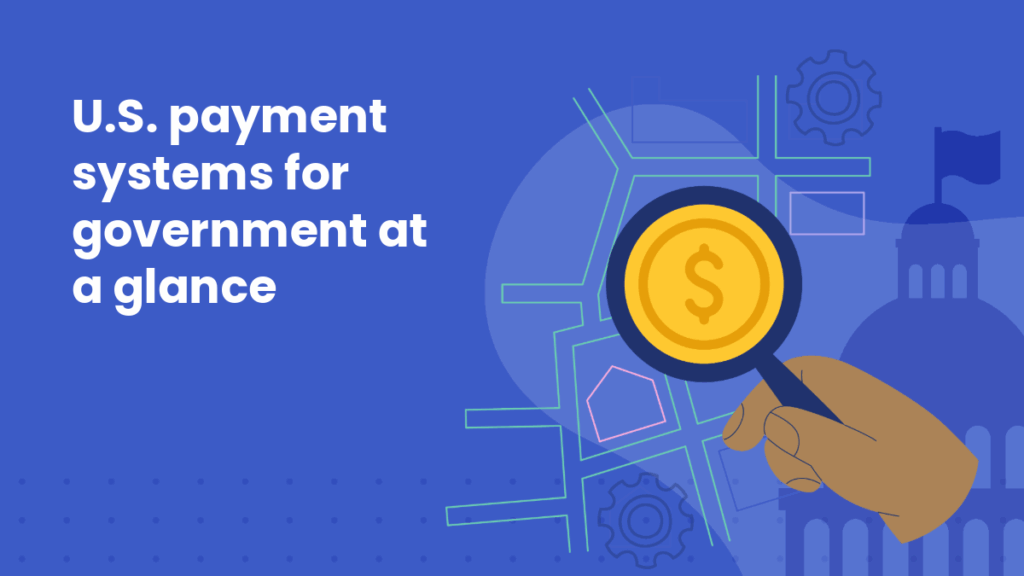Digital Government Trends to Watch Closely in 2022

With digital government transformation initiatives on the rise, 2022 is promising for agencies and the citizens they serve. State and local government technology trends suggest an increased focus on improving the digital experience of residents and agencies’ employees alike.
Worldwide government IT spending will grow 6.5% to $557.3 billion in 2022, according to Gartner. From this total, 64% will be directed to solutions that enhance the resilience and responsiveness of public services.
Here are five GovTech trends to keep a close eye on this year:
1. Government IT modernization
For a growing number of state and local agencies, 2022 is the year to say goodbye to legacy systems that create silos of data and security gaps. A survey from the National Association of State Chief Information Officers (NASCIO) lists legacy modernization among the top technology priorities for state CIOs in 2022. Digital government trends like this point to the need to update systems, revamp processes and better share data among different agencies.
Moving out of silos is critical to rapidly scale operations and respond to new citizen demands. According to a Gartner forecast, “by 2025, over 50% of government agencies will have modernized critical core legacy applications to improve resilience and agility.”
Modern, cloud-based platforms also become crucial as more employees work remotely. As Forrester predicts, “One-third of global civil servants will become permanent hybrid workers.” IT modernization can also help to attract and retain skilled workers. For 72% of surveyed government executives in the 2021 KPMG report on modern government, outdated IT systems hurt the ability to recruit new talent.
Legacy systems can impact governments’ budgets, too. Research indicates that 42% of agencies were spending more than a quarter of their IT budgets to maintain legacy systems in 2019. Forrester’s Total Economic Impact™ (TEI) study of deploying PayIt’s SaaS platform confirms this cost-saving trend. By freeing up personnel from supporting deficient legacy solutions, PayIt’s clients see increased productivity of the IT staff—a benefit that amounts to $629,326 over three years.
Updating legacy technology is also critical to closing security gaps. Cybersecurity tops the lists of 2022 priorities for state CIOs, per the NASCIO’s State CIO study. Ransomware attacks have escalated over the last years, and those breaches often start with the exploit of unpatched vulnerabilities.
2. SaaS government platforms
Cloud solutions help governments improve not only security but also service delivery. NASCIO’s study reveals that software-as-a-service (SaaS) is State CIOs’ no. 1 priority for the year in terms of government technology. Gartner also confirms this digital government trend, predicting that service solutions will account for 95% of new IT investments by 2025.
With a SaaS government platform, agencies can expand their service offerings. A platform such as PayIt leverages common components and databases so that governments can continually add new features and services. In its report on 2022 tech trends for government, Deloitte highlights the scalable nature of SaaS solutions, noting that “as this trend gains momentum, deploying applications will become a process of assembly rather than creation—a shift that could reorder the entire value stack.”
As seen with Shelby County Trustee’s Office, a fully integrated and scalable platform can help governments continuously grow their offerings as citizens’ expectations evolve. Launched in 2017, payit901 allows Shelby County to collect and disburse property tax more efficiently. Citizens can find, view and pay property tax online. Features such as scheduled payments and electronic billing were added in the following years, giving citizens more options.
3. Multichannel citizen experience
Consumers picked up new online behaviors during the COVID-19 pandemic and now have higher expectations about their digital experience. As Forrester notes as part of its 2022 predictions for the public sector, “Customers are the new market-makers.” They want 24/7 access to government services from anywhere and any device. In other words, they want multichannel service delivery.
With PayIt, governments can consolidate hundreds of services into one centralized citizen experience. Residents can make their payments via:
- Self-service web portal
- Mobile app (Apple iOS or Android)
- Interactive voice response (IVR)
- Contactless point-of-sale (POS) terminals
By investing in an omnichannel strategy, agencies can improve citizen engagement. Shelby County, for example, went from 49,900 online transactions in 2018 to 72,500 in 2020.
Building a digital government is so important that it ranks second among the top priorities for state CIOs in 2022 in NASCIO’s study, only behind cybersecurity.

Source: NASCIO
4. Digital wallets
The use of digital identity and payment apps in government is part of the broader mobile wallet trend. According to Juniper Research, total spend via digital wallets will exceed $10 trillion in 2025, an 83% growth from 2020. The adoption of contactless digital payments as a more secure and convenient method during the pandemic has driven this trend in the public sector, too.
With PayIt’s digital wallet, residents can store documents, receipts and preferred payment methods in one secure place. Another advantage is that citizens can link accounts with different government departments and see them all in one centralized location. This GovTech trend brings the convenience of not having to deal with single-purpose authentication for each government department. According to Gartner‘s forecast, “By 2023, at least 80% of government services that require authentication will support access through multiple digital ID providers.”
5. Government automation
Automation is a key component of government digital transformation initiatives. This technology trend leverages the use of artificial intelligence (AI) and robotic process automation (RPA) to eliminate manual processes and accelerate service delivery. As per NASCIO’s State CIO Survey, AI and RPA rank among the top 5 CIO priorities for 2022 in terms of government technology.
With government workflow automation, agencies can reduce paper forms and manual processing, freeing up employee’s time from repetitive and low-value tasks. In its 2022 predictions for the public sector, Forrester anticipates that “10 percent of government administrative workload will be automated.” An automated workflow triggers notifications and obtains approvals, eliminating the need for human intervention to move the process forward.
With the COVID-19 pandemic, conversational chatbots in government have also gained momentum. Powered by AI or rules-based “if/then” logic, chatbots can help deliver 24/7 government services and boost citizen engagement. A global survey by Accenture indicates that 78% of citizens see benefits to using virtual agents such as chatbots to receive government services. Half of the respondents believe that a virtual agent can help them solve their queries quickly.
Accelerate your digital government transformation in 2022 with PayIt
Ready to take a leap into government digital transformation? Get in touch with us.
We can guide you through the latest government technology trends and all we can do to help you streamline your operations and enhance the citizen experience. Book a demo now.
Looking for more content?
Get articles and insights from our monthly newsletter.





